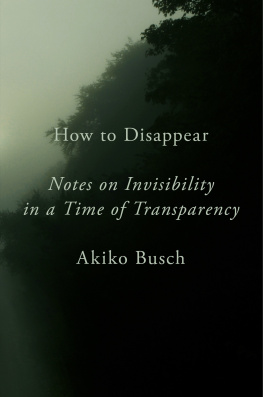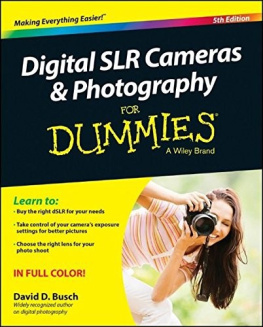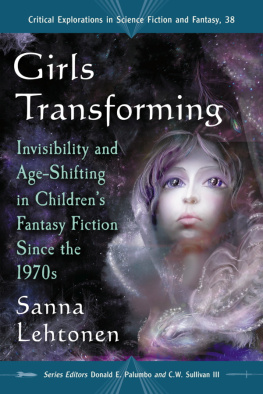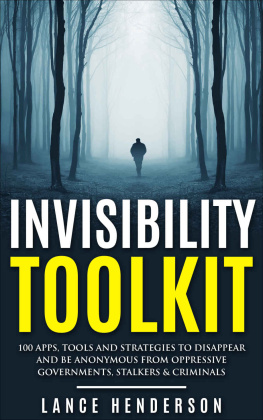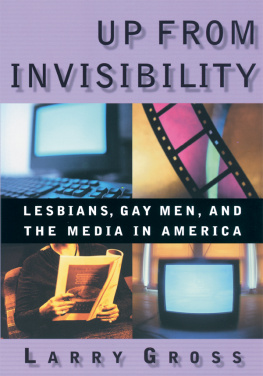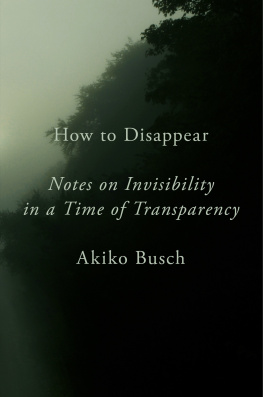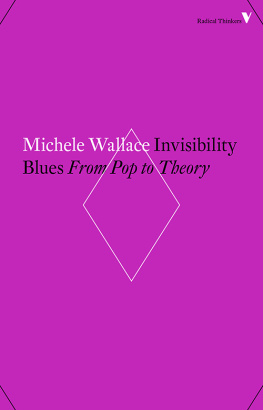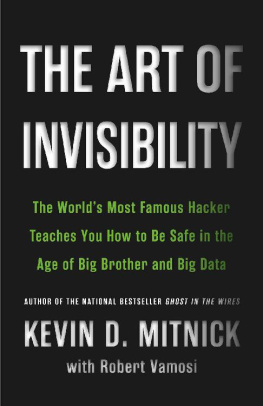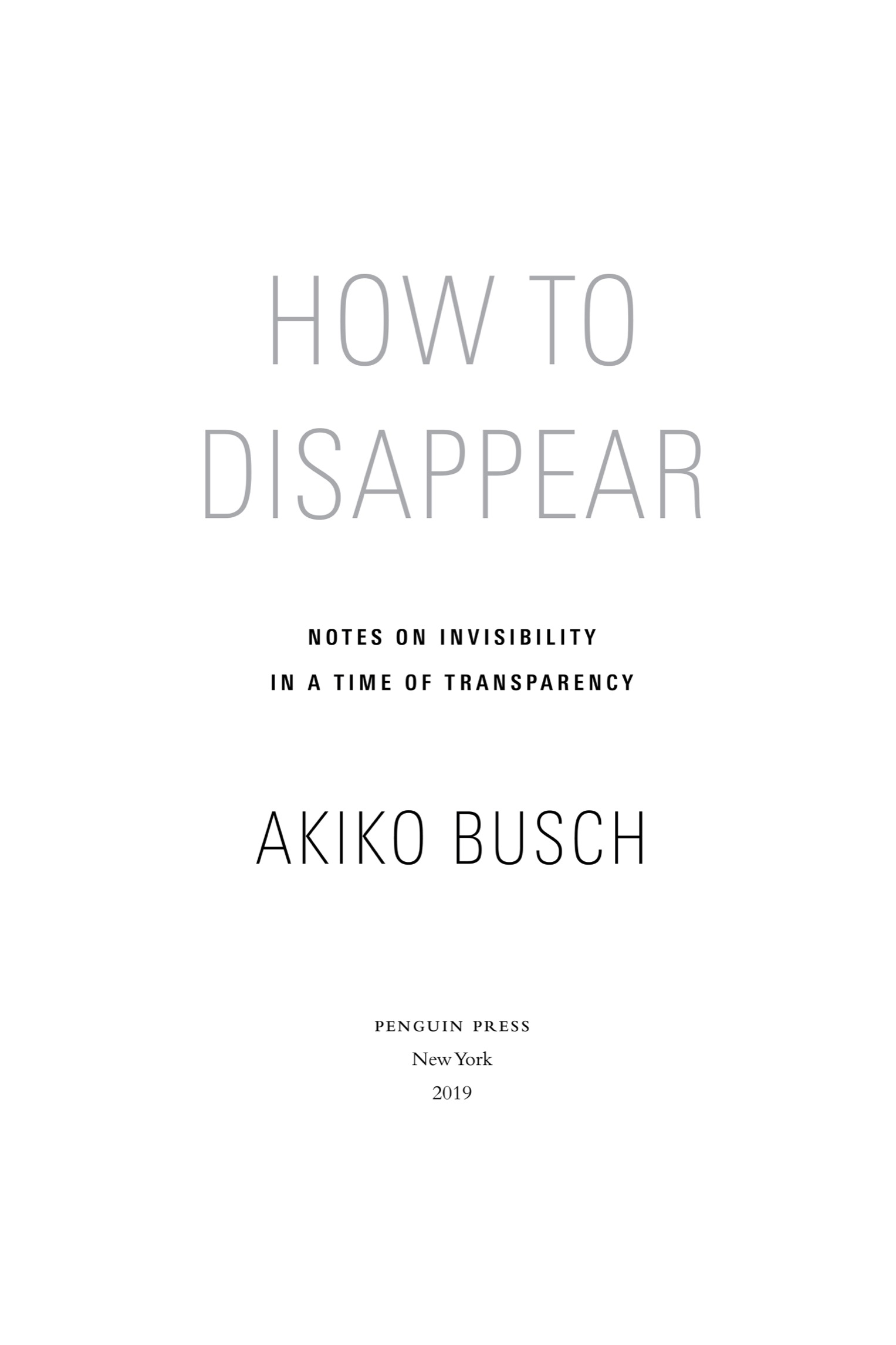Penguin supports copyright. Copyright fuels creativity, encourages diverse voices, promotes free speech, and creates a vibrant culture. Thank you for buying an authorized edition of this book and for complying with copyright laws by not reproducing, scanning, or distributing any part of it in any form without permission. You are supporting writers and allowing Penguin to continue to publish books for every reader.
Names: Busch, Akiko, author.
Title: How to disappear : notes on invisibility in a time of transparency / Akiko Busch.
Description: New York : Penguin Press, 2019. | Includes bibliographical references.
Identifiers: LCCN 2018029070 (print) | LCCN 2018036687 (ebook) | ISBN 9781101980439 (ebook) | ISBN 9781101980415 (hardcover)
Subjects: LCSH: InvisibilitySocial aspects.
Clouds gather visibility, and then disperse into invisibility. All appearances are of the nature of clouds.
INTRODUCTION
The more invisible something is, the more certain its been around.
JOSEPH BRODSKY
I pull myself up to the makeshift platform in the lower branches of the white oak. It has been wrenched awry after years of neglect, and the rungs leading to the damp, rotting platform have been pulled out of place. The whole geometry of the thing has gone askew, conforming more to the chaos of the woods now than to whatever plan a hunter had years ago when he leveled the boards and nailed them into position. Still, this small, mossy podium is not an uncomfortable place to take in this forest of oak, maple, beech, hickory, ash and to see what I can of the forest, and what I cannot.
Its unusually warm for early March. In New Yorks Hudson Valley, winter often finds a way to linger late into this month, but in 2016, the peepers from the wetlands nearby have already started their rhapsodic chirping. On this particular afternoon, the forest floor is damp, with the only bits of color the green moss and silvery lichen, a scattering of wild chive sprouting up in the bed of dry leaves, and the last few red winterberries. The tree canopy remains wide-open, afternoon light flooding the hillside. On my way up to the ridge, I surprise a ring-necked pheasant and two eastern bluebirds, whose low warble picks up at the sound of my steps. I hear raspy, distant cawing from a handful of raucous crows but doubt they are reacting to my presence. Crows are capable of recognizing human faces, but I am not familiar to them. It has been months since Ive visited this ridge.
An eastern gray squirrel momentarily stops scuttling along an upper branch of a maple tree a few yards away. With eyes on either side of its head which have a highly focused wide-angle vision, it can see me without moving. But the squirrel has only moderate color vision, and a yellow pigment in its lenses naturally reduces glare. Smell and light are as vital to how it perceives the exterior world. Its perception of me has as much to do with my scent and shadow as with my actual form. Its nest, one of the messy arrangements of leaves, twigs, and bark assembled in the upper reaches of this forest, will be fully camouflaged once the leaves have come in.
After thirty minutes or so, a slight rustle alerts me to a doe, the color of dust and bark, twenty feet away. She stops midstep and stares toward me, tilting her head. My own invisibility is a matter of silence and immobility. She nibbles on a tuft of grass emerging through the leaf litter and then steps quietly through the woods, past the platform, and down the ridge into the hollow, where she happens upon a pheasant. It screeches and flaps its wings, and the doe bounds up the opposite hill. Deer are unable to make the color distinctions that we make. They have discerning nighttime vision and can see light in the blue, violet, and ultraviolet range, the last of which is not visible to us. But they are unable to detect reds and oranges. Sound and movement, rather than shape and color, are what alert them to human presence. I dont know what she sees, but I assume it is a handful of indistinct shapes in a range of violet hues.
Birds not only perceive gradations of color we miss, but extra color cones in their retinas allow them to perceive other hues that we are unable even to imagine. Snakes are equipped with pit organs on either side of their heads to detect the warmth of what is around them; capable of infrared sight, they navigate the world by reading the heat signatures of the prey that may be nearby. By discerning ultraviolet light, bees see patterns of flowers invisible to us and use them to locate nectar. They process color as much as five times faster than humans, seeing the way colors change with angle and perceiving iridescence where we do not. The black-eyed Susans outside my kitchen door have discs of hues on their petals I cannot see, and when I take in the radiance in a field of sunflowers in July, it is bright with patterns that remain out of my view. The range of visible light apparent to us is only a small part of the electromagnetic spectrum. The entire world is shining with things we cannot see.
A place actually called a blind seems like a good spot to begin thinking about being unseen and the conditions under which we become visible. To the doe, it is not my vaguely concealed form or my brown sweater, but my stillness that keeps me out of view. For the crows, it is my unfamiliarity, and for the gray squirrel, my shadow. My own vision is limited to an arc of 120 degrees, most of that peripheral, and I know this invisibility conference includes insects, amphibians, rodents, and birds that entirely escape my notice. What is the difference between being invisible and just landing in a blind spot?
In the woods no more than an hour, I am struck anew by invisibility, and its improvisational choreography, as a necessary condition of life. I am reminded of the grace of reticence, the power of discretion, and the possibility of being utterly private and autonomous yet deeply aware of and receptive to the world. If I am enchanted by staying out of sight, it is because such behavior seems so rare in our own species. In recent years, we have been more preoccupied than ever by the question of how to stay in view.
Yet we humans have our own diverse ways of being seen or unseen. We have our own metrics of invisibility, and our vision is a matter that goes beyond the electromagnetic spectrum. We make ourselves known or not, and familiarity, color blindness, and peripheral vision are the least of it. We have devised a vast catalog of inventive strategiesphysical, psychological, technologicalfor how we maneuver our way in and out of one anothers sight lines. They can be captivating, enchanting, deceptive, manipulative, hopeful, despairing, gracious, isolating, logical, illogical, strange, and altogether mysterious. This age of increasing transparency is time to consider them anew.

